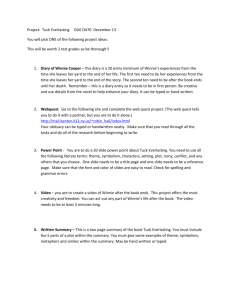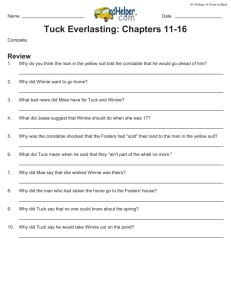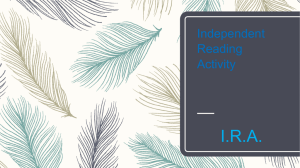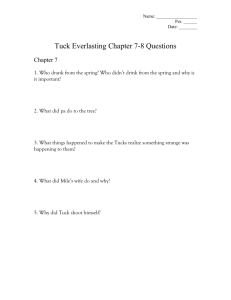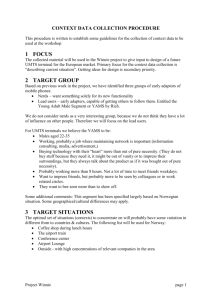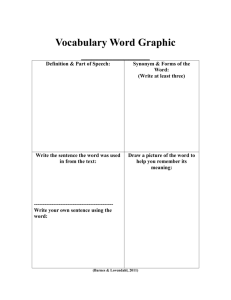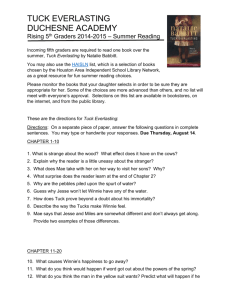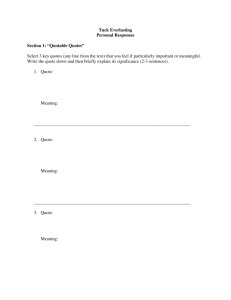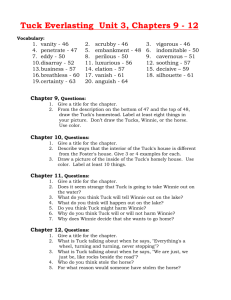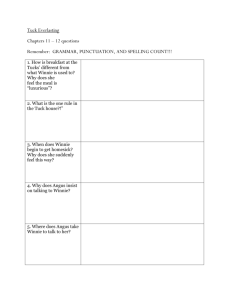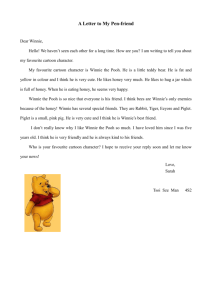Tuck Everlasting Unit Plan: 5th Grade Reading
advertisement
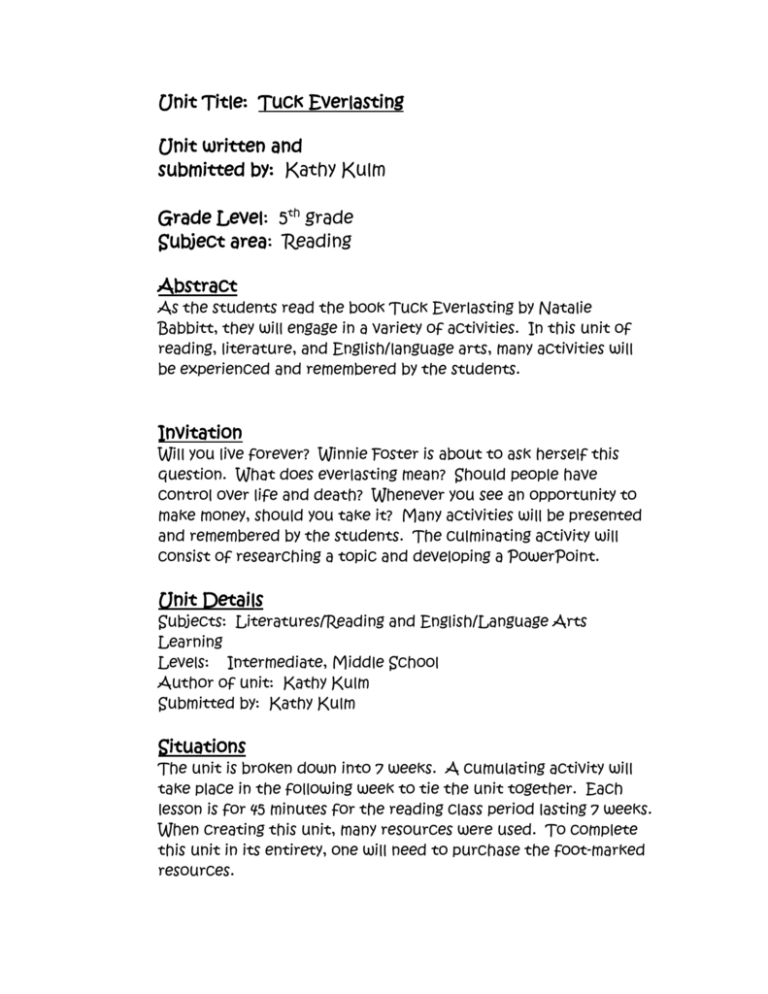
Unit Title: Tuck Everlasting Unit written and submitted by: Kathy Kulm Grade Level: 5th grade Subject area: Reading Abstract As the students read the book Tuck Everlasting by Natalie Babbitt, they will engage in a variety of activities. In this unit of reading, literature, and English/language arts, many activities will be experienced and remembered by the students. Invitation Will you live forever? Winnie Foster is about to ask herself this question. What does everlasting mean? Should people have control over life and death? Whenever you see an opportunity to make money, should you take it? Many activities will be presented and remembered by the students. The culminating activity will consist of researching a topic and developing a PowerPoint. Unit Details Subjects: Literatures/Reading and English/Language Arts Learning Levels: Intermediate, Middle School Author of unit: Kathy Kulm Submitted by: Kathy Kulm Situations The unit is broken down into 7 weeks. A cumulating activity will take place in the following week to tie the unit together. Each lesson is for 45 minutes for the reading class period lasting 7 weeks. When creating this unit, many resources were used. To complete this unit in its entirety, one will need to purchase the foot-marked resources. Tasks Week One (in the classroom) (Friday computer lab for journal) Prewriting to these questions: *What does everlasting mean to you? *Would you like to live forever at the age you are today? Small group: Brainstorm for responses then regroup and create a class chart to display the information gathered. Discuss the word forever. Discuss the word fantasy. *(Modern Fantasy” contains imaginary elements that are contrary to reality, as we know it. Such as talking animals or toys, it may manipulate time and space, create imaginary worlds or give humans strange powers.) *Have the students identify other pieces of literature that they have read that contain the elements of fantasy. Reading Chapter 1-5 Task: *Hand out vocabulary sheets. Read through and discuss each. Review daily. (attachment) *Write in journal on computer on Friday. (attachment) The students will work on their journal entries in the computer lab from the main server. *Answer the comprehension questions either in writing or orally at the end of each week. If the questions are answered in writing, their thoughts will be in their daily journals. *Why is Winnie discontent at the beginning of the story? *Why is Winnie afraid to run away? *Why does Winnie talk to the toad? *Quiz-comprehension and vocabulary (resource #1 page 13) Friday Activities Divide into two groups: one group will create watercolor art (resource #1 page 16), the other group will be discussing and creating their own music box. (resource #1 page 14) Week Two (in the classroom) (Friday in the computer lab for journal) Reading Chapter 6-11 Tasks: *Continue with vocabulary sheets. (attachment) Read through and discuss each. *Read Chapters 6-11 (Group, individually, and in partners) *Write in journals on computer. (attachment) *Answer comprehension questions in writing or orally at the end of the chapters. *Why does Winnie decide that she wants to go home at the end of Chapter 11? *Why doesn’t Jesse want Winnie to drink from the spring? *Why does Winnie begin to feel happy about being kidnapped? *Discuss figurative language and complete activity. (resource 1 page 21) Quiz-comprehension and vocabulary (resource #1 page 18) Friday Activities Language (in the classroom and in the computer lab) The student with a partner will create a travel brochure. They will use their imagination to expand on the information they have from the story to make people want to take a vacation in Treegap. (resource 1 page 19) (Due Week 4 Monday) Science (in the classroom and in the computer lab) Using the science book and Internet discuss toads and frogs. *Research the similarities and differences between the two using the Venn diagram. (resource 1 page 31) http://www.sdcoe.k12.ca.us/score/actbank/tvenn.htm Life cycles for frogs… http://members.tripod.com/tinaford/index.html *Bulletin Board Idea: create the Venn diagram and illustrations with labels for each. (Due Week 5 Monday) Week Three (in the classroom and computer lab on Friday) Reading-Chapter 12-18 Continue with vocabulary sheet. Read through and discuss each. Review each daily. Read Chapters 12-18 (Group, individually, and in partners) Write in journal on computer (attachment) *Answer comprehension questions either in writing or orally at the end of these chapters. *What trade does the man in the yellow suit make with the Fosters? *How does the man in the yellow suit blackmail the Fosters? *Why is the constable surprised that the Fosters agree to sell the woods? Friday Activities (attachments) *Terrariums-Science (resource #1 page 24) http://www.artmakers.com/terrcare.html http://www.blackjungle.com/ju01000.htm http://www.agric.gov.ab.ca/agdex/200/8501801.html http://www.track0.com/canteach/elementary/life5.html *Poetic Thoughts-Language (resource #1 page 27) *Distance-Time-Rate-Math resource #1 page 26) Week Four (in the classroom) (Friday in the computer lab for journal) *The students will present and hand in their travel brochures. (Rubric) Reading – Chapters 19-25 *Continue with vocabulary sheets. Read through and discuss each. Review each daily. *Read Chapters 19-25 (Group, individually, and in partners) *Write in journal on computer (attachment) *Answer comprehension questions either in writing or orally at the end of these chapters. *Why does Winnie lie about the circumstances of her “snatching”? *If Mae cannot die, why is everyone so concerned about her getting the “gallows”? *Are the Tucks criminals? Why or why not? *Is Winnie a criminal? *Foreshadowing: Why do you think the author told you that Winnie is given a bottle of water from Jesse? *Quiz-comprehension and vocabulary (resource #1 page 28) Friday Activities *Standing Up for What You Believe. (1) small group then large group discussion. (resource 1 page 32) *”In the News” activity-will be assigned on Friday and presented the next Friday. (resource #1 page 30) Week Five (in the classroom) (Friday in the computer lab for journal) *The students will share their frog and toad research reports. Reading- Read the Epilogue. *Continue with the vocabulary packet. Read through and discuss each. Review daily. *Write in journal on the computer (attachment) *Answer comprehension questions either in writing or orally at the end of the epilogue. *Why do you feel the epilogue is important or not important to the story? *Why does Tuck say “Good girl” when he sees that Winnie is dead? Friday Activities *Present “In the News” presentation from last Friday. (Rubric) *The Years Make a Difference-Social Studies (resource #2 page 11) *Time Line (group activity) (resource #1 page 36) (Possibly create a bulletin board or poster of the changes over time.) Week Six (in the classroom) (also in the computer lab for research) Begin culminating activity of the research activity. Research activity with a PowerPoint presentation. (Rubric) (2 days research and 3 days PowerPoint) (resource #1 page 40) The student will pick a topic from the list and research and develop a better understanding of such topics enhance one’s appreciation of the book and its author. The presentation will be on the Monday of the Week 7. Week Seven (in the classroom) *The students will design a wheel and divide it into 8 equal pieces and then write about 8 important life goals they have and predict the results of their goals. (This would be a terrific activity to file away for the students in their later years) Objective test (resource #1 pages 43-44-45 three options) Comparison between the book and the movie. A calendar is included for the due dates and completions. (Calendar) Interactions The students will work collaboratively in groups, pairs, and independently throughout the unit on various activities. The teachers will work one-on-one with individual students when warranted. For the most part the teacher will facilitate learning opportunities. The classroom will take on a number of environment settings-open for group interaction and project creating; more structured when individual work is being completed; and of course the computer lab. To ensure completeness to aide in comprehension, the students’ personal checklist will provide students focus and direction. (Checklist) Projects For student modifications, the group and partner work is necessary for the success of the learner in certain situations to benefit in their success. **Also depending on the abilities of your classroom, the number of Friday activities can vary from one to all. Spelling lists and assignments are included if you would like to incorporate these with your lessons. List 1 List 2 Crossword puzzle Word Search Standards Fifth grade Reading Standards The student will: 7. determine the author’s underlying theme or message through the actions, motives, and appearances of characters in various works of fiction. 8. describe the function and effect of key literary elements and devices in various texts. (example: cause-and-effect relationships, imagery, symbolism, and rhythmical patterns) 9. describe how an author’s choice of vocabulary and style contribute to the quality and enjoyment of the selections. Fifth grade Writing Standards The student will: 1. use various stages of the writing process. (example: brainstorming, drafting, revising, editing, and publishing) 16. write to organize information according to category, situation, issue, or topic. 18. use technologies to share written work with others and to receive feedback. (example: e-mail, Internet) 20. edit for capitalization, punctuation, and spelling. (example: proper adjectives, quotation marks, commas, commonly misspelled words) 21. revise manuscripts to improve effectiveness. (example: sentence structure, complete sentences) Fifth grade Listening and Viewing Standards The student will: 9. identify ways to determine the reliability of information. (example: research, support, proof) Fifth grade Speaking Standards The student will: 6. communicate various messages clearly, precisely, and effectively. Assessment As a class, we will check off the assignments that have been completed off each student’s checklist. The quizzes at the end of each section will be relatively easy to assess and grade giving the students a weekly grade in reading class. For the journal on the computer, the teacher will keep a checklist of each week to show that each student has participated in this activity. As the students are writing, the teacher will circulate the room to ensure participation and help, if need. Comprehension questions and correlating worksheets will be graded at the end of each section. A rubric will correspond with the Travel Brochure, “ In the News” activity, and also the culminating activity with the PowerPoint presentation. Tools Computer with Internet access and also tools from the resource guide listed below. Tuck Everlasting written by Natalie Babbitt; Scholastic Inc., 555 Broadway, New York, NY 10012, by arrangement with Farrar, Straus & Giroux, Inc. Trumpet; Copyright 1975. ISBN 0-590-98886-7 Resources 1 Tuck Everlasting Literature Unit written by Caroline Nakajima, Illustrated by Sue Fullam; Teacher Created Materials, Inc. P.O. Box 1040, Huntington Beach, CA 92647; Copyright 1992 ISBN 1-55734-408-6 2 Tuck Everlasting Scholastic Literature Guide Grades 4-8; written by Linda Ward Beech; Scholastic Professional Books, 2931 McCarty Street, Jefferson City, MO 65102; Copyright 1997 ISBN 0-590-37354-4 3 Tuck Everlasting written by Natalie Babbitt; Scholastic Inc., 555 Broadway, New York, NY 10012, by arrangement with Farrar, Straus & Giroux, Inc. Trumpet; Copyright 1975. ISBN 0-590-98886-7
